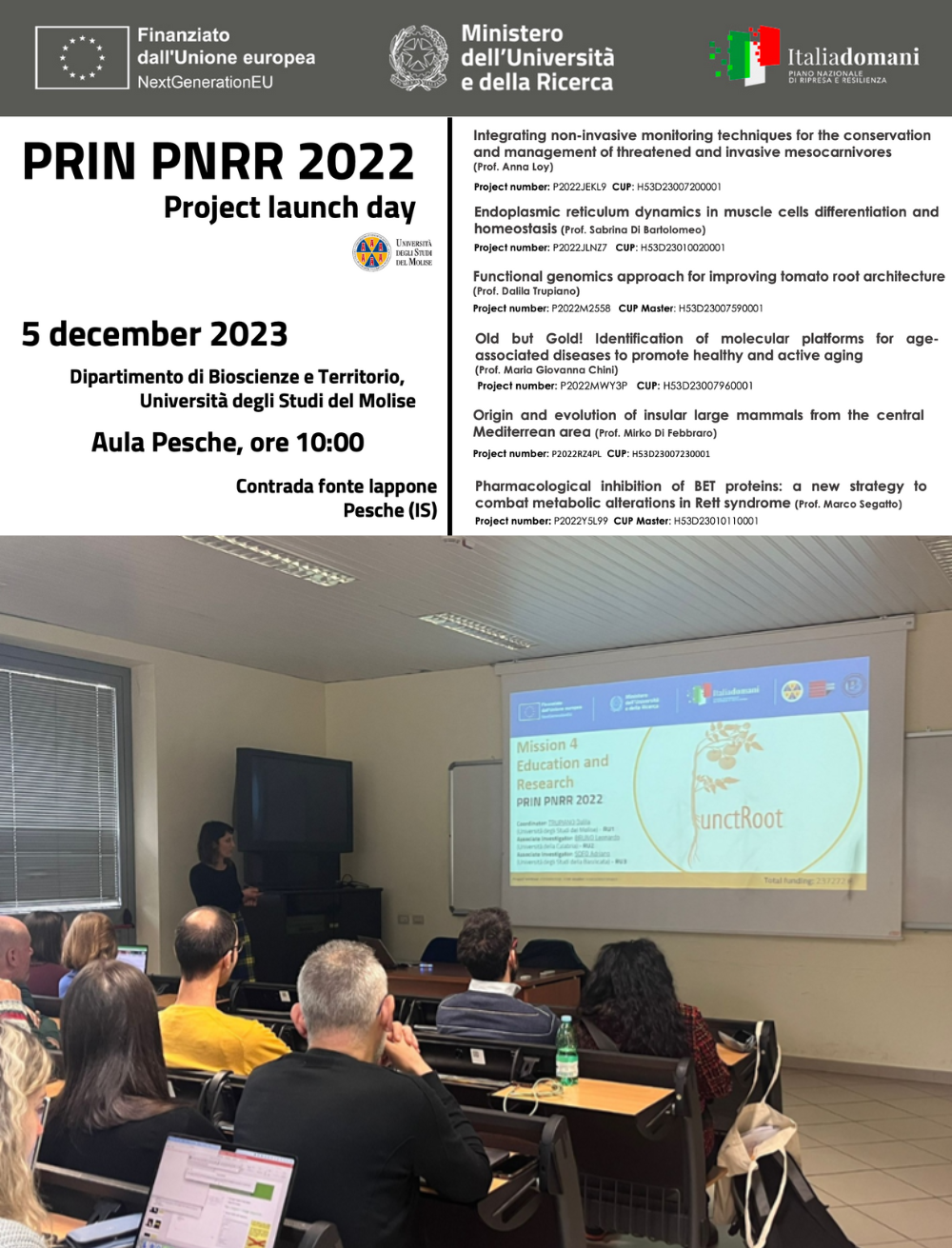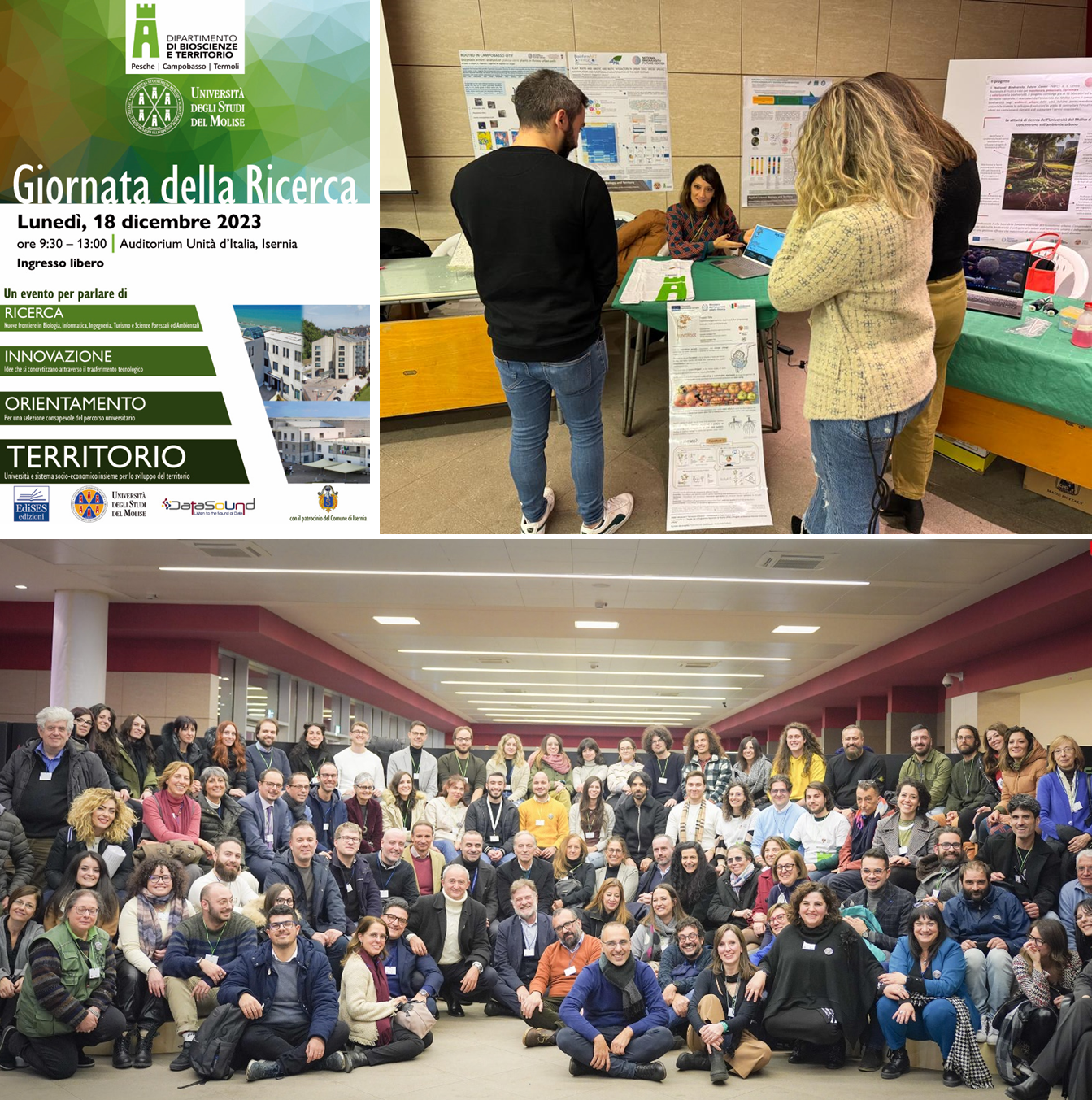

PRIN 2022 PNRR project titled “Functional genomics approach for improving tomato root architecture” (FunctRoot; ERC: LS3_8; Project number: P2022M2558; CUP Master: H53D23007590001) funding from the European Union – Next-GenerationEU – National Recovery and Resilience Plan (NRRP) – MISSION 4 COMPONENT 2, INVESTIMENT N. 1.1, D.D. n. 1409 del 14-09-2022. Total Budget: 237272 €
Working Group

Dalila Trupiano
Principal Investigator
University of Molise
Budget: 85.422€

Leonardo Bruno
Associate Investigator
University of Calabria
Budget: 83.730€

Adriano Sofo
Associate Investigator
University of Basilicata
Budget: 68.120€

Mohamed Kougen
Ph.D. Student
XXXVII cycle in Biology and Applied Sciences PhD Course
University of Molise

Antonio Scopa
Associate Professor
University of Basilicata
Brief Description
Due to population growth, urbanization, and climate change, the competition for water resources is expected to increase, with a relevant impact on plant growth and survival, particularly, in the agrosystems, where it is used for irrigation.
Notably, different plant species are able to counteract drought conditions by modulating the shape, size and functionality of the root system that ultimately determine plant access to water. Although much is known about root traits and functioning, there is a need for better understanding of root phenotyping in the context of the strategies adopted by plants to face water scarcity. Thus, an area of interest is examining the genetic determinant for improvement of root traits able to increase water use efficiency and, expressly, the maintenance of productivity in plants grown under drought conditions.
Recently, research on root plasticity has focused on the utility of specific root traits under water limitation, and an increasing number of quantitative trait loci (QTL) and genes have been found in different crop/model species. Among them, DRO1 was found to be a major root QTL in rice and Arabidopsis, and it is strictly related to deep-growing root systems, allowing plants to reach deeper groundwater and survive during drought periods. However, it is notable that the specific root traits regulated by this gene (root angle, root length, etc.) were distinct in the above-mentioned plant species. Therefore, expanding this study to other crop species could provide the necessary resources and reference to improve their productivity and performance under water shortage, putting this understanding into practice.
In this scenario, FunctRoot aims at functionally characterizing the DRO1-controlled root phenotype in tomato (Solanum lycopersicum L.), an important crop grown worldwide, particularly sensitive to drought. A phenomic approach combined with cutting-edge genomics technologies, such as overexpressed construct lines and CRISPR/Cas9 genome editing, will be the key to decipher the mechanisms underlining tomato root architecture changes under drought stress. In detail, experiments in controlled conditions will be designed to: i) understand how the tested drought constraints affect tomato root development; ii) unravel the role of DRO1 gene in the control of root architecture by functionally characterizing gain- and loss of functions mutant lines in physiological and drought stress conditions; iii) reveal the potential key regulators and related signaling-interacting DRO1 networks; iv) identify candidate genes linked with tomato root development and plant resistance to water stress. Three research teams (RU1 and PI – Dalila Trupiano, University of Molise; RU2 – Leonardo Bruno, University of Calabria; RU3 – Adriano Sofo, University of Basilicata), with strong expertise in the sector of root development and stress response, will be in charge of executing this innovative research project.
The integrated DRO1 gene functional characterization proposed within FunctRoot will put the basis to enhance scientific knowledge on root traits. The results of FunctRoot will be of practical importance, allowing tomato plants subjected to water shortage to access soil water and nutrients, so increasing plant productivity under a changing climatic scenario. Furthermore, FunctRoot will have direct and tangible influence on water management in cultivated ecosystems, which therefore fully meets to the strategic emerging topic “Sustainability and protection of natural resources” (Cluster 6), strictly related to National Recovery and Resilience Plan and Horizon Europe 2021-2027 targets.
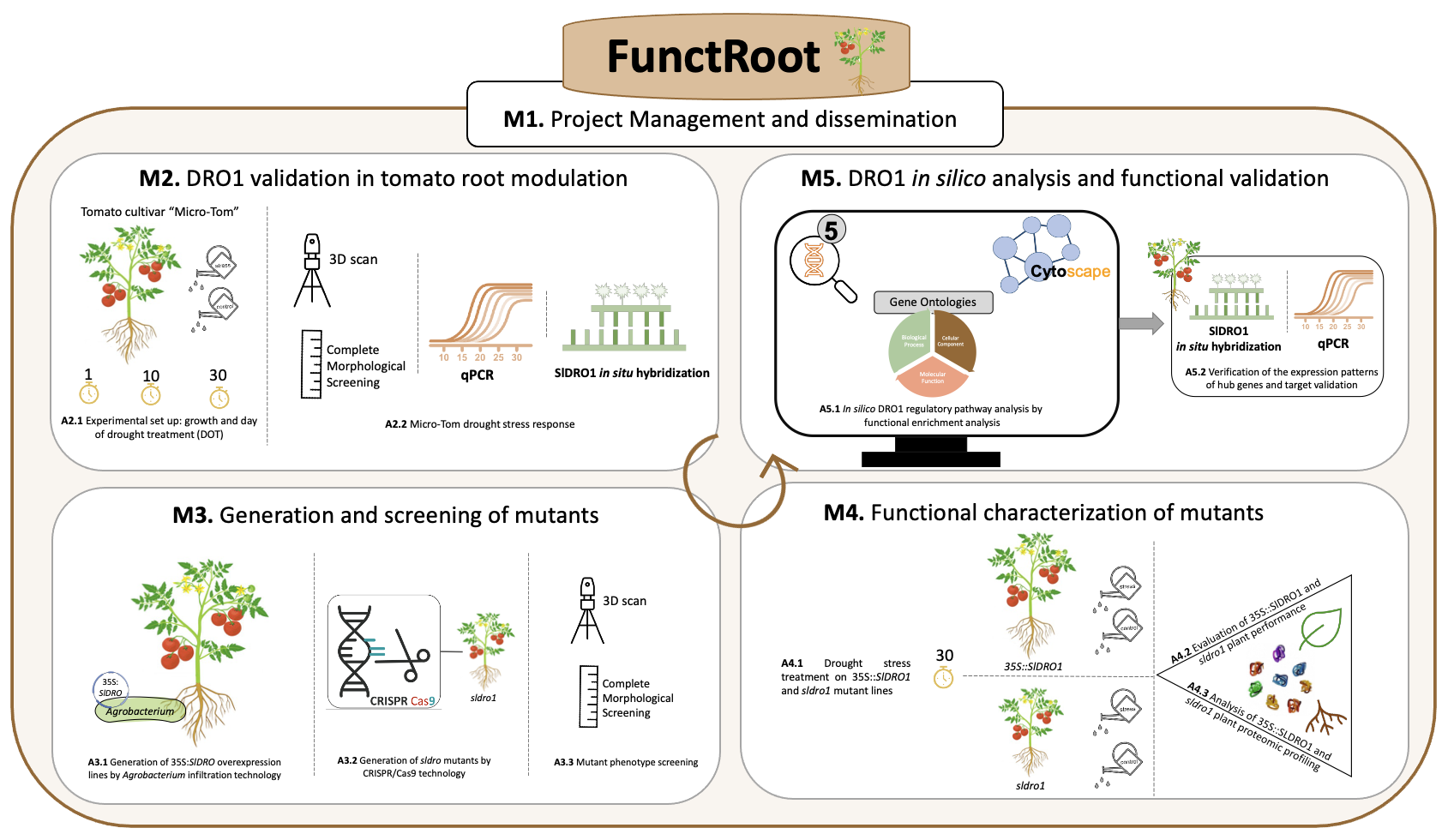
Detailed Project description
FunctRoot plan will include specific work packages, each of them preparatory to the next step, and characterized by clear milestones (M), requirements/methodologies (Activity – A and Actions) and deliverables (D), drawn to effectively to monitor the project’s progress. A continuous and close collaboration among the three RUs will be implemented to interchange expertise and ensure a high level of integration among the project steps, maximizing the reliability of generated products. The planned sequence of M, A/Actions, and D characterizing FunctRoot are described in the figure and workflow below.
M1 – Project Management and dissemination (all RUs). Monitor the activities of all WPs, addressing and implementing eventual corrective actions, through a kick-off meeting (bimester 1), a mid-term meeting (bimester 6), and a final meeting (bimester 12). Revision/evaluation of the project achievements (A1.1; D1.1), and subsequent dissemination and communication activities (A1.2; D1.2).
M2 – Validation of DRO1 gene role in the modulation of tomato root system (RU2 and RU3). To determine if DRO1 gene plays also a role in the modulation of tomato RSA, Micro-Tom plants will be subjected to drought treatment (A2.1 – D2.1) and, successively, the expression of SlDRO1 (Solyc12g049380) will be assayed, via qPCR and in situ hybridization, on different plant organs (A2.2 – D2.2). Finally, the main plant traits related to drought stress response will be identified (A2.3 – D2.3).
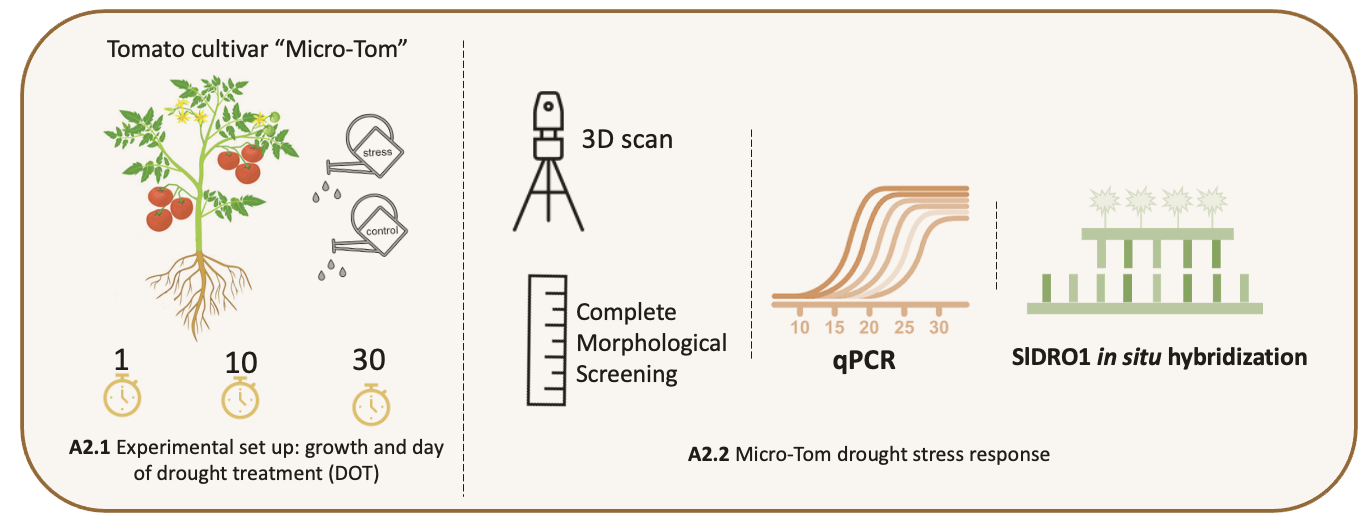
M3 – Generation and screening of 35::SlDRO1 overexpressed and sldro1 mutant lines (all RUs). SlDRO1 (Solyc12g049380) gain- and loss-of-function mutants will be generated (A3.1 and A3.2 – D3.1 and D3.2), and phenotype-recapitulated (A3.3 – D3.3). The results will constitute a significant base for further functional studies (M4) that will provide new insights into the developmental mechanism of the tomato root system.
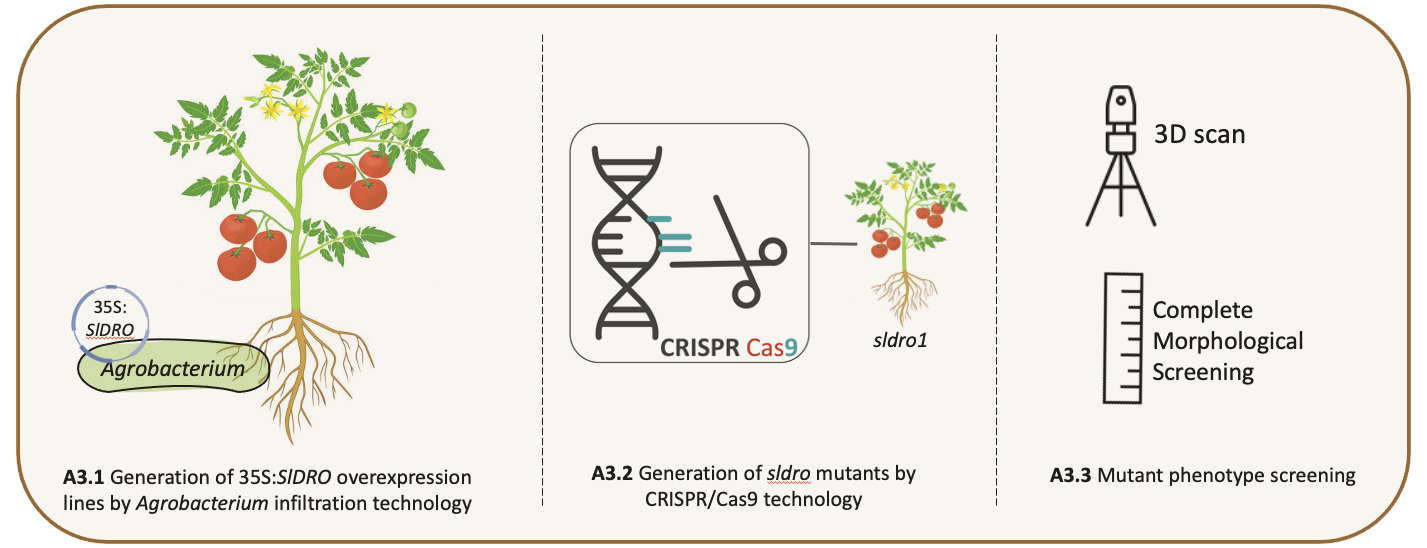
M4 – Functional characterization of 35S::SlDRO1 and sldro1 mutant lines (RU1 and RU3). A selected number of 35S::SlDRO1 and sldro1 mutant lines (max. 3 for each) will be subjected to drought stress treatment (A4.1 and D4.1), followed by a functional characterization at the morpho-physiological (A4.2 and D4.2) and molecular levels (A4.3 and D4.3). Conserved/or not conserved function of SlDRO1 as a regulator of lateral root angle and root depth from rice/Arabidopsis to tomato will then be confirmed.
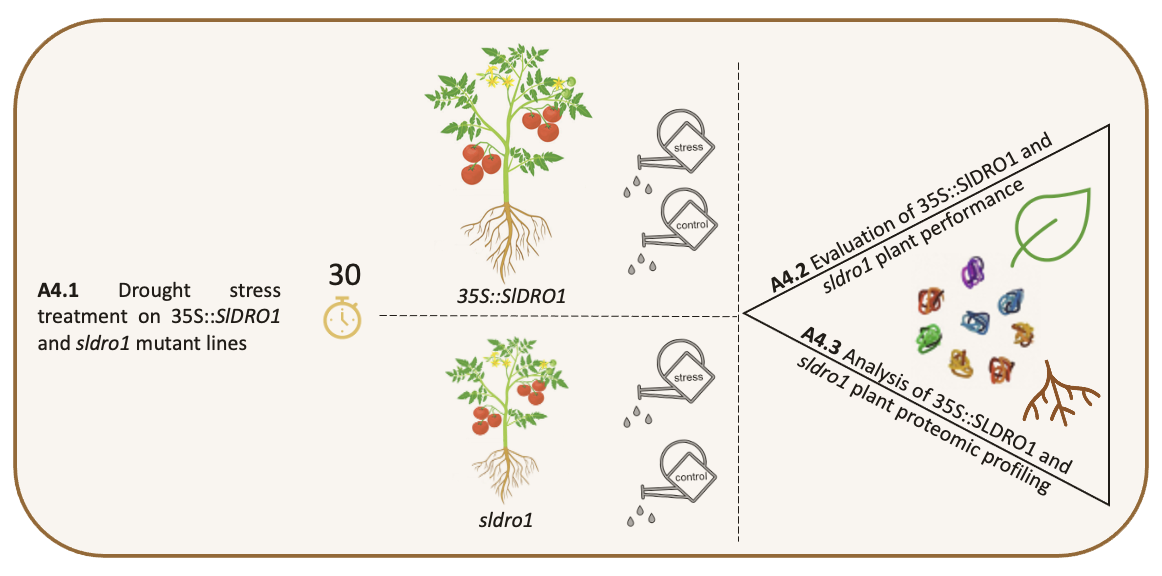
M5 – Identification and validation of SlDRO1 network and related target genes (RU1 and RU2). A comprehensive in silico SlDRO1 network-based analysis, successively validated in wet lab, will be used to explore the relationships between different gene sets, genes and phenotypes, and identifying/validating centrally connected hub genes, and providing a straightforward biologically-functional interpretations of gene co-expression networks modulating root architecture (A5.1-5.3; D5.1-5.3).
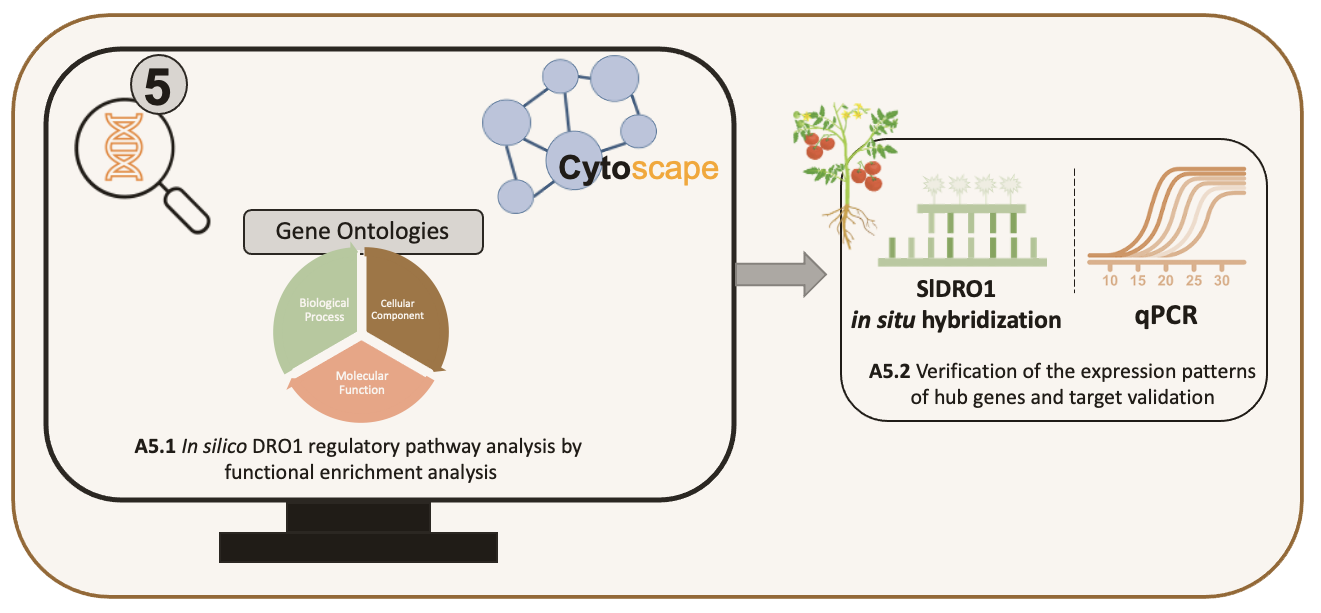
News and Events
The project has been marked out with dedicated meetings and divulgation activities:
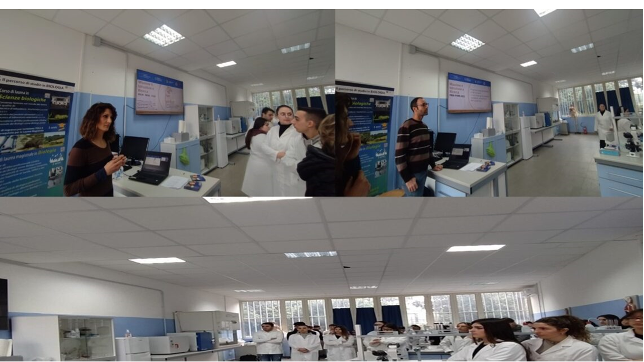
- https://www2.unimol.it/blog/2024/01/22/settimana-della-tecnologia-e-della-ricerca-scientifica-unimol-e-la-biologia-allitis-majorana-di-cassino/;
- https://m.facebook.com/story.php?story_fbid=pfbid0j9dqiDaSUvdfyBH2aQ965kQuNNuX7sCE68d4pWTvGNGdPtjCjPzPaPwqF5qr4SAUl&id=100064308234683;
- https://www.ilpuntoamezzogiorno.it/2024/01/settimana-della-tecnologia-e-della-ricerca-scientifica-i-progetti-dellateneo-del-molise/.

